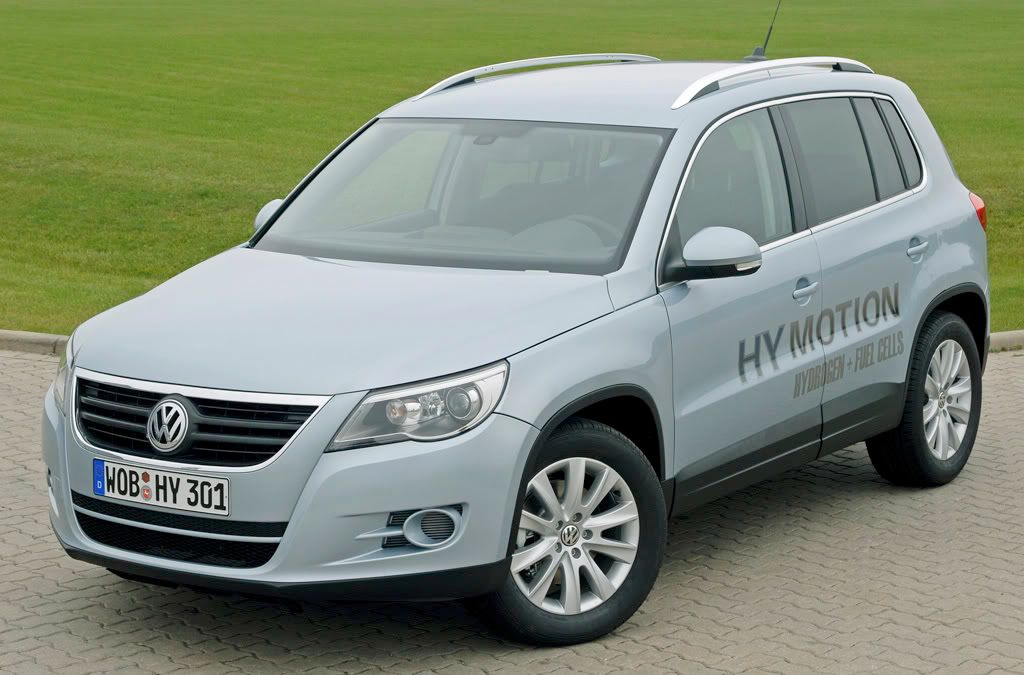Hydrogen powered Tiguan HY.MOTION @ the 2007 Michelin Challenge Bibendum
Posted by phaeton at 4:02 pm

While the space up! blue was presented at the LA Auto Show, VW was busy showing its future Technology Studies at the 2007 Michelin Challenge Bibendum in Shanghai, China.
All of VW's latest engine tech was shown, such as the BlueMotion, BlueTDI aka Clean TDI, Combined Combustion technology (CCS), TSI EcoFuel (Natural Gas) and Hydrogen Studies one of them this Tiguan HY.MOTION shown after the jump....
2007 Bibendum Challenge - Tiguan HyMotion with fuel cell
World exclusive: Tiguan HyMotion with fuel cell
Prototype of Tiguan HyMotion is the first fuel cell SUV by Volkswagen
Fuel cell of the Tiguan HyMotion develops system power of 80 kW
Wolfsburg / Shanghai, 14 November 2007
In Shanghai, for the first time in the world Volkswagen is presenting a SUV prototype with a fuel cell: the Tiguan HyMotion. Compared to the recently introduced Touran HyMotion, performance of the fuel cell drive has been further improved, and its efficiency has been optimized. The fuel cell system with an output power of 80 kW was integrated in the Tiguan’s engine compartment. The electric motor operates here too. It develops a maximum power of 100 kW. The top speed of the Tiguan HyMotion is 150 km/h; the prototype, weighing in at 1,870 kilograms, accelerates from 0 to 100 km/h in about 14 seconds.
A lithium ion battery with a charge capacity of 6.8 Ampere-hours (Ah) serves as an auxiliary energy storage device. Its maximum power output is 22 kW. The battery is charged by recovered braking energy (recuperation) or by the fuel cell. The battery system is installed in the trunk, specifically beneath the dual cargo floor that can be ordered on the production Tiguan. The 700 bar hydrogen tank was integrated in the area beneath the rear bench seat and the cargo area. It can hold up to 3.2 kilograms of hydrogen (H2). Interior space is not impaired by the fuel cell drive system.
Basic operation of fuel cells
The key component of each individual fuel cell - a number of them are combined into a stack - is a proton-conducting membrane. It is located between each anode and cathode pair. Hydrogen flows on the anode side, and air flows into the cell on the cathode side. When many of these cells are combined in a stack, enough energy can be generated to drive a vehicle. In each cell, hydrogen and oxygen react to form water on the cathode side. The fuel cell thereby converts chemical energy directly into electrical energy in an oxidation process, a so-called “cold” combustion process. The generated “exhaust” is nothing but clean water vapor.
The fuel cell is supplied from the hydrogen tank and an external air inlet. The fuel cell outputs the electrical energy it generates - the power - via a converter and a downstream electrical system rectifier - to one or more electric motors. The resulting car is nearly silent when driven, and it is always driven emissions-free.
Source:Volkswagen
Labels: fuel cell, HY.MOTION, hydrogen, Tiguan, volkswagen











<< Home